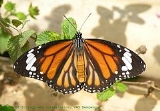
Danaus genutia
Encyclopedia

Butterfly
A butterfly is a mainly day-flying insect of the order Lepidoptera, which includes the butterflies and moths. Like other holometabolous insects, the butterfly's life cycle consists of four parts: egg, larva, pupa and adult. Most species are diurnal. Butterflies have large, often brightly coloured...
of India. It belongs to the "Crows and Tigers", that is, the danainae group of the Brush-footed butterflies
Nymphalidae
The Nymphalidae is a family of about 5,000 species of butterflies which are distributed throughout most of the world. These are usually medium sized to large butterflies. Most species have a reduced pair of forelegs and many hold their colourful wings flat when resting. They are also called...
family. The butterfly is also called Striped Tiger in India
India
India , officially the Republic of India , is a country in South Asia. It is the seventh-largest country by geographical area, the second-most populous country with over 1.2 billion people, and the most populous democracy in the world...
to differentiate it from the equally common Plain Tiger Danaus chrysippus
Danaus chrysippus
Danaus chrysippus, known as the Plain Tiger or African Monarch, is a common butterfly which is widespread in Asia and Africa. It belongs to the Danainae subfamily of the brush-footed butterfly family, Nymphalidae...
.
Description
_in_kawal,_ap_w_img_1804.jpg)
In drier regions the tawny part of the hindwing pales and approaches white in colour making it very similar to the White Tiger (D. melanippus).
Subspecies
It has some 16 subspecies
Subspecies
Subspecies in biological classification, is either a taxonomic rank subordinate to species, ora taxonomic unit in that rank . A subspecies cannot be recognized in isolation: a species will either be recognized as having no subspecies at all or two or more, never just one...
; its evolution
Evolution
Evolution is any change across successive generations in the heritable characteristics of biological populations. Evolutionary processes give rise to diversity at every level of biological organisation, including species, individual organisms and molecules such as DNA and proteins.Life on Earth...
ary relationships are not completely resolved, but it appears to be closest to the Malay Tiger (D. affinis) and White Tiger.
Distribution and ecology
D. genutia is distributed throughout IndiaIndia
India , officially the Republic of India , is a country in South Asia. It is the seventh-largest country by geographical area, the second-most populous country with over 1.2 billion people, and the most populous democracy in the world...
, Sri Lanka
Sri Lanka
Sri Lanka, officially the Democratic Socialist Republic of Sri Lanka is a country off the southern coast of the Indian subcontinent. Known until 1972 as Ceylon , Sri Lanka is an island surrounded by the Indian Ocean, the Gulf of Mannar and the Palk Strait, and lies in the vicinity of India and the...
, Myanmar
Myanmar
Burma , officially the Republic of the Union of Myanmar , is a country in Southeast Asia. Burma is bordered by China on the northeast, Laos on the east, Thailand on the southeast, Bangladesh on the west, India on the northwest, the Bay of Bengal to the southwest, and the Andaman Sea on the south....
and extending to South East Asia and Australia
Australia
Australia , officially the Commonwealth of Australia, is a country in the Southern Hemisphere comprising the mainland of the Australian continent, the island of Tasmania, and numerous smaller islands in the Indian and Pacific Oceans. It is the world's sixth-largest country by total area...
(except New Guinea
New Guinea
New Guinea is the world's second largest island, after Greenland, covering a land area of 786,000 km2. Located in the southwest Pacific Ocean, it lies geographically to the east of the Malay Archipelago, with which it is sometimes included as part of a greater Indo-Australian Archipelago...
). At least in the South Asia
South Asia
South Asia, also known as Southern Asia, is the southern region of the Asian continent, which comprises the sub-Himalayan countries and, for some authorities , also includes the adjoining countries to the west and the east...
n part of its range it is fairly common, locally very common.
This butterfly occurs in scrub jungles, fallowland adjacent to habitation, dry and moist deciduous forests, preferring areas of moderate to heavy rainfall. Also occurs in degraded hill slopes and ridges, both, bare or denuded, and, those covered with secondary growth.
While it is a strong flier, it never flies rapidly or high. It has stronger and faster strokes than the Plain Tiger. The butterfly ranges forth in search of its host and nectar plants. It visits gardens where it nectars on the flowers of Adelocaryum, Cosmos
Cosmos
In the general sense, a cosmos is an orderly or harmonious system. It originates from the Greek term κόσμος , meaning "order" or "ornament" and is antithetical to the concept of chaos. Today, the word is generally used as a synonym of the word Universe . The word cosmos originates from the same root...
, Celosia
Celosia
Celosia is a small genus of edible and ornamental plants in the amaranth family, Amaranthaceae. The generic name is derived from the Greek word κηλος , meaning "burned," and refers to the flame-like flower heads. Species are commonly known as woolflowers, or, if the flower heads are crested by...
, Lantana
Lantana
Lantana is a genus of about 150 species of perennial flowering plants in the verbena family, Verbenaceae. They are native to tropical regions of the Americas and Africa but exist as an introduced species in numerous areas, especially in the Australian-Pacific region. The genus includes both...
, Zinnia
Zinnia
Zinnia is a genus of 20 species of annual and perennial plants of family Asteraceae, originally from scrub and dry grassland in an area stretching from the American Southwest to South America, but primarily Mexico, and notable for their solitary long-stemmed flowers that come in a variety of bright...
and similar flowers.
Defence against predators, mimicry
Members of this genus are leathery, tough to kill and fake death. Since they are unpleasant to smell and taste, they are soon released by the predators, recover and fly off soon thereafter. The butterfly sequesters toxins from its foodplants of the family AsclepiadaceaeAsclepiadaceae
According to APG II, the Asclepiadaceae is a former plant family now treated as a subfamily in the Apocynaceae...
. The butterflies also congregate with other danaiines to sip from the sap of Crotolaria, Heliotropium
Heliotropium
Heliotropium is a genus of flowering plants in the borage family, Boraginaceae. There are 250 to 300 species in this genus, which are commonly known as heliotropes ....
and other plants which provide the pyrrrolizidine alkaloid
Alkaloid
Alkaloids are a group of naturally occurring chemical compounds that contain mostly basic nitrogen atoms. This group also includes some related compounds with neutral and even weakly acidic properties. Also some synthetic compounds of similar structure are attributed to alkaloids...
s which they sequester. A study in Northeastern India showed a preference to foraging on Crotalaria juncea compared to Bauhinia purpurea
Bauhinia purpurea
Bauhinia purpurea is a species of flowering plant in the family Fabaceae, native to South China and Southeast Asia. Common names include Hong Kong Orchid Tree, Purple camel's foot, and Hawaiian orchid tree.-Description:...
, Barleria cristata rosea
Barleria cristata
Barleria cristata , is a plant of the Acanthaceae family.-Distribution and habitat:It is native to a wide area raanging from Southern China to India and Myanmar....
and Nerium oleander. To advertise their unpalatability, the butterfly has prominent markings with a striking colour pattern. The Striped Tiger is mimic
Mimic
In evolutionary biology, mimicry is the similarity of one species to another which protects one or both. This similarity can be in appearance, behaviour, sound, scent and even location, with the mimics found in similar places to their models....
ked by both sexes of the Indian Tamil Lacewing Cethosia nietneri mahratta and the Leopard Lacewing Cethosia cyane
Cethosia cyane
The Leopard Lacewing is a species of heliconiine butterfly found from India to southern China , and Indochina. Its range has expanded in the last few decades, and its arrival in the southern part of the Malay Peninsula, including Singapore, is relatively recent.-Description:-Male:Upperside tawny,...
and females of the Common Palmfly Elymnias hypermnestra
Elymnias hypermnestra
The Common Palmfly, Elymnias hypermnestra, is a species of satyrid butterfly found in south Asia.-Description:As some other species in the genus Elymnias, the Common Palmfly presents a precostal cell on the hindwings and a hair tuft of androconial scales on dorsal discal cell of hindwings.This...
.
Life history
This butterfly lays its egg singly under the leaves of any of its hostplants of family AsclepiadaceaeAsclepiadaceae
According to APG II, the Asclepiadaceae is a former plant family now treated as a subfamily in the Apocynaceae...
. The caterpillar
Caterpillar
Caterpillars are the larval form of members of the order Lepidoptera . They are mostly herbivorous in food habit, although some species are insectivorous. Caterpillars are voracious feeders and many of them are considered to be pests in agriculture...
is black and marked with bluish-white and yellow spots and lines. It has three pairs of tentacles on its body. It first eats the eggshell and then proceeds to eat leaves and vegetative parts of the plant. The chrysalis (pupa) is green and marked with golden yellow spots.
Food plants
The caterpillar of the Common Tiger butterfly obtains a supply of poison by eating poisonous plants, which makes the caterpillar and butterfly a distasteful morsel for predators. The most common foodplants of the Common Tiger in Peninsular India are small herbs, twiners and creepers from the family AsclepiadaceaeAsclepiadaceae
According to APG II, the Asclepiadaceae is a former plant family now treated as a subfamily in the Apocynaceae...
, including:
- Asclepias curassavicaAsclepias curassavicaAsclepias curassavica, commonly called Mexican Butterfly Weed, Blood-flower, Scarlet Milkweed or, Tropical Milkweed, is a species of flowering plant in the dogbane family, Apocynaceae. It is native to the American tropics....
- Ceropegia intermedia
- Cynanchum dalhousieae
- Raphistemma pulchellum
- StephanotisStephanotisStephanotis, is a genus of flowering plants. The name derives from the Greek 'stephanos' crown and 'otis' ear which refers to the arrangement of the stamens in the flower which are ear shaped. Genus of 5-15 species of evergreen, woody-stemmed climbers from tropical woodland in Africa. They are...
spp. (including S. floribundaStephanotis floribundaStephanotis floribunda is a flowering climbing plant. Its trumpet shaped blooms are in season year-round, and are a popular component of bridal bouquets. It is vigorous climber, tough stemmed, bearing dark green leathery leaves, which grow in pairs at regular intervals along the vine...
?) - Tylophora tenuis
See also
- Danainae
- NymphalidaeNymphalidaeThe Nymphalidae is a family of about 5,000 species of butterflies which are distributed throughout most of the world. These are usually medium sized to large butterflies. Most species have a reduced pair of forelegs and many hold their colourful wings flat when resting. They are also called...
- List of butterflies of India
- List of butterflies of India (Nymphalidae)

